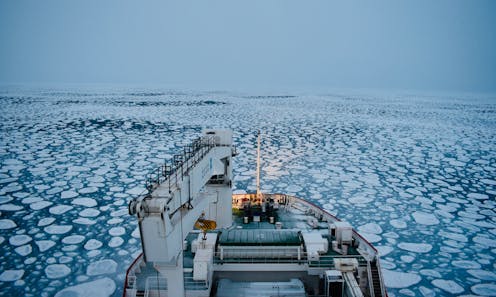Scientists are divining the future of Earth’s ice-covered oceans at their harsh fringes
- Written by Jordan Peter Anthony Pitt, Post-Doctoral Researcher, University of Adelaide

One of the harshest and most dynamic regions on Earth is the marginal ice zone – the place where ocean waves meet sea ice, which is formed by freezing of the ocean’s surface.
Published today, a themed issue of the journal Philosophical Transactions of the Royal Society A reviews the rapid progress researchers have made over the past decade in understanding and modelling this challenging environment.
This research is vital for us to better understand the complex interactions of Earth’s climate systems. That’s because the marginal ice zone plays a role in the seasonal freezing and thawing of the oceans.
A harsh place to study
In the Arctic and Antarctic, surface ocean temperatures are persistently below -2℃ – cold enough to freeze, forming a layer of sea ice.
At the highest latitudes closer to the poles, sea ice forms a solid, several-metre-thick lid on the ocean that reflects the Sun’s rays, cooling the region and driving cool water around the oceans. This makes sea ice a key component of the climate system.
But at lower latitudes, as the ice-covered ocean transitions to the open ocean, sea ice forms into smaller, much more mobile chunks called “floes” that are separated by water or a slurry of ice crystals.
This marginal ice zone interacts with the atmosphere above and ocean below in a very different way to ice cover closer to the poles.
It’s a challenging environment for scientists to work in, with a voyage into the marginal ice zone around Antarctica in 2017 experiencing winds over 90km/h and waves over 6.5m high. It is also difficult to observe remotely because the floes are smaller than what most satellites can see.
Crushed by waves
The marginal ice zone also interacts with the open ocean via surface waves, which travel from the open waters into the zone, impacting the ice. The waves can have a destructive effect on the ice cover, by breaking up large floes and leaving them more susceptible to melt during summer.
By contrast, during winter, waves can promote the formation of “pancake” floes, so called because they are thin disks of sea ice (you can see them in the image above).
Drone footage from Canada shows waves generated by a ship breaking up continuous ice into floes.But wave energy itself is lost during interactions with floes, so that waves gradually become weaker as they travel deeper into the marginal ice zone. This produces wave–ice feedback mechanisms driving sea ice evolution in a changing climate.
For example, a trend for warmer temperatures will weaken the ice cover, allowing waves to travel deeper into ice-covered oceans and cause more breakup, which further weakens the ice cover – and so on.
Scientists studying marginal ice zone dynamics aim to improve our understanding of the zone’s role in the dramatic and often perplexing changes the world’s sea ice is undergoing in response to climate change.
For instance, in the Arctic Ocean, sea ice cover has “has dropped by roughly half since the 1980s”. In the Antarctic, the sea ice cover has recently had both one of its largest and smallest recorded extents, with the marginal ice zone being one source of year-to-year variability.
Our progress in better understanding these harsh regions has revolved around large international research programs, run by the United States’ Office of Naval Research and others. These programs involve earth scientists, geophysicists, oceanographers, engineers and even applied mathematicians (like us).
Recent efforts have produced innovative observation techniques, such as a method to 3D-image wave and floe dynamics in the marginal ice zone from onboard an icebreaker and capture waves-in-ice from satellite images.
They have also resulted in new models capable of simulating the interaction of waves and ice from the level of individual floes to the overall behaviour of entire oceans. The advances have motivated an Australian led multi-month experiment in the Antarctic marginal ice zone, on the new $500M icebreaker RSV Nuyina, which is expected next year.
The marginal ice zone will be an increasingly important component of the world’s sea ice cover in the future, as temperatures rise and waves become more extreme.
Despite the rapid progress, there is still some way to go before the understanding of feedback processes in the marginal ice zone translates into improved climate predictions used by, for example, the International Panel on Climate Change Assessment Reports.
Including the marginal ice zone in climate models has been described as the “holy grail” for the field by one of its leading figures, and the theme issue points to closer ties with the broader climate community as the next major direction for the field.
Read more: Ice shelves hold back Antarctica's glaciers from adding to sea levels – but they're crumbling
Authors: Jordan Peter Anthony Pitt, Post-Doctoral Researcher, University of Adelaide





